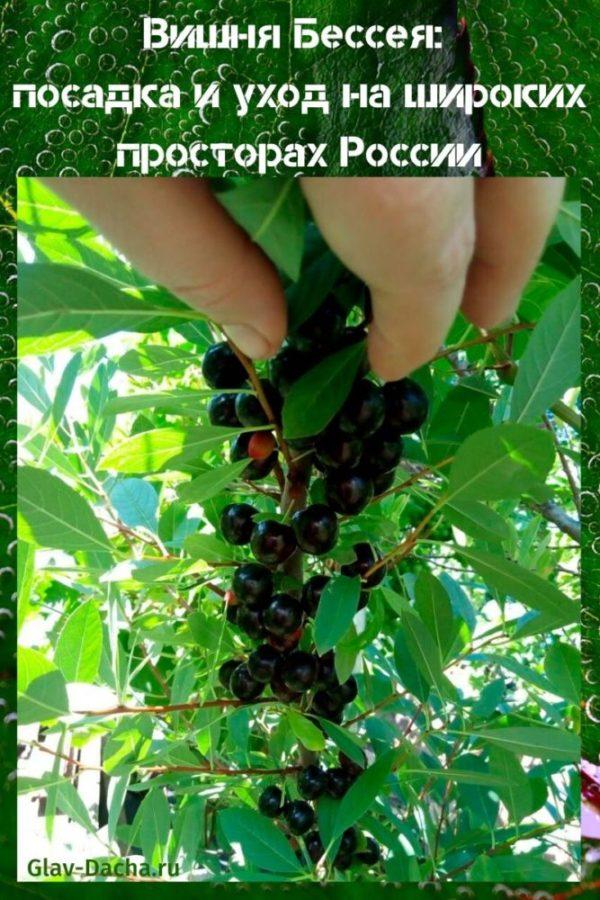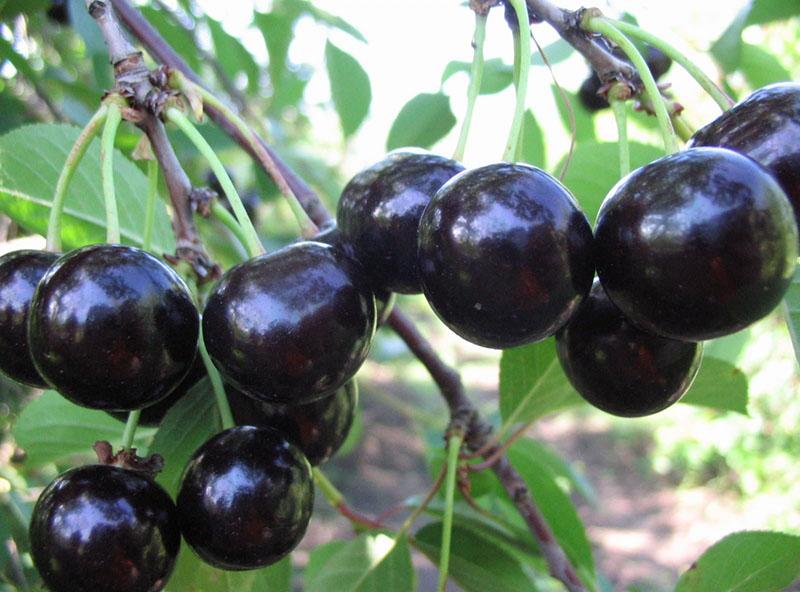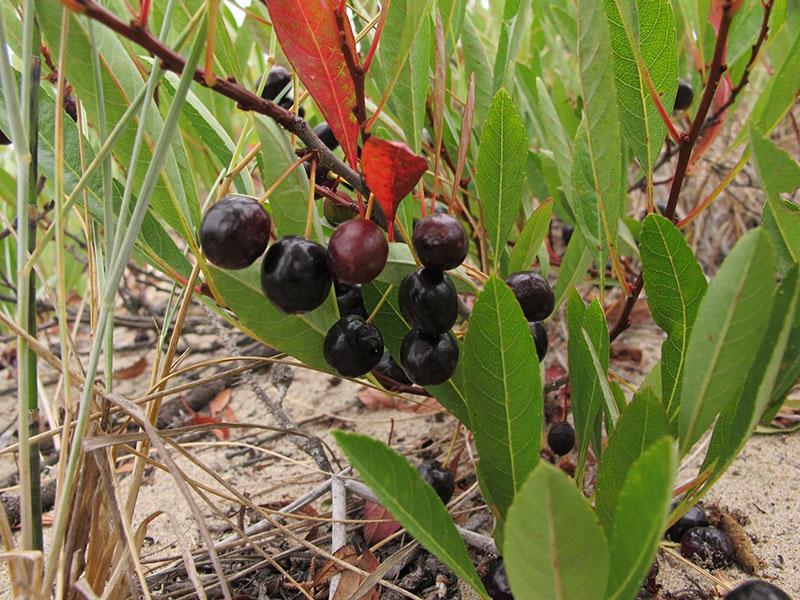Cherry Besseya: planting and care in the wide open spaces of Russia
 In Russia, the Bessey cherry, planting and caring for which is possible in a harsh climate and on marginal soils, remains an underestimated crop. It is widespread in the Far East, the Urals, Siberia, but there are not so many really good, tasty varieties. The species Cerasus besseyi is sweet, but tart, often with an astringent pulp, eating its berries fresh is a dubious pleasure.
In Russia, the Bessey cherry, planting and caring for which is possible in a harsh climate and on marginal soils, remains an underestimated crop. It is widespread in the Far East, the Urals, Siberia, but there are not so many really good, tasty varieties. The species Cerasus besseyi is sweet, but tart, often with an astringent pulp, eating its berries fresh is a dubious pleasure.
Description of sandy cherries Bessey

From a botanical point of view, Besseya is closer to the plum and apricot... With them, she interbreeds and pollinates. Steppe cherries, ordinary cherries and sweet cherries with sandy are useless even to graft on each other.
 The culture is referred to as micro cherries. Crossbreeding with felted and ferruginous resulted in good, tasty hybrids.
The culture is referred to as micro cherries. Crossbreeding with felted and ferruginous resulted in good, tasty hybrids.
Species Besseya is a multi-stemmed shrub 1-1.5 m high with a crown diameter of up to 2 m. Young shoots grow vertically, drooping with age. At 7 years old, they begin to creep, and by 10-12 years they die off.
Skeletal branches are dark gray, new growth is reddish brown. The root system is characterized by weak anchoring, that is, it “clings” poorly to the ground. Otherwise, Besseya would be an excellent stock for plums, apricots, contributing to the advancement of these crops to the north.
 The leaves of western sand cherry are leathery, with a solid edge, a sharp tip, narrow and long, up to 6 cm. The outer part of the plate is green, the lower part is gray with silver. Before winter Besseya turns red, and not all leaves fall off even after the onset of frost and snow.
The leaves of western sand cherry are leathery, with a solid edge, a sharp tip, narrow and long, up to 6 cm. The outer part of the plate is green, the lower part is gray with silver. Before winter Besseya turns red, and not all leaves fall off even after the onset of frost and snow.
Flowers and fruits
 Flowering begins late, in many regions - by the end of May or early June. White buds, when fully expanded, reaching a diameter of 1.5 cm, completely wrap the bush, exude a light aroma, last for 2-3 weeks.
Flowering begins late, in many regions - by the end of May or early June. White buds, when fully expanded, reaching a diameter of 1.5 cm, completely wrap the bush, exude a light aroma, last for 2-3 weeks.
 Bessei's fruits ripen unevenly from the end of August. They are round or oval, usually brown or black, weighing up to 2 g, in especially favorable conditions, some berries reach 3 g. There are cultivars with green or yellow ovaries, some, after ripening, gain weight up to 5 g.
Bessei's fruits ripen unevenly from the end of August. They are round or oval, usually brown or black, weighing up to 2 g, in especially favorable conditions, some berries reach 3 g. There are cultivars with green or yellow ovaries, some, after ripening, gain weight up to 5 g.
 The pulp is tender, juicy, greenish, sometimes with reddish veins. The taste is sweet, astringent and very tart, with little or no sourness. It differs not only from season to season, but also differs in plants grown from cuttings or seeds taken from one mother plant.
The pulp is tender, juicy, greenish, sometimes with reddish veins. The taste is sweet, astringent and very tart, with little or no sourness. It differs not only from season to season, but also differs in plants grown from cuttings or seeds taken from one mother plant.
After full ripening, Bessei berries do not fall off. They hang on the bushes for a long time, wither, which is why their consumer qualities only increase - the astringency decreases.
In species plants, the fruits are tasteless, but they look very beautiful. In addition, planting and maintenance of Bessey cherries is so simple that they can be included in the list of crops that practically do not require care.
Culture characteristics
Besseya is an easy-care, stable, fast-growing, but short-lived plant. It makes sense to grow it in areas of risky farming, where winters are especially harsh, and other stone fruit crops simply will not survive.
Resistance to adverse factors
 In North America, Besseya tolerates a drop in temperature to -50 ° C. In Russia, already at -40 ° C, the aboveground part can freeze out.For timber to ripen, a hot summer is needed, which can provide growth in the steppe (prairie). But in the same latitude of Siberia and the Far East there are forests, therefore, the temperature is much lower.
In North America, Besseya tolerates a drop in temperature to -50 ° C. In Russia, already at -40 ° C, the aboveground part can freeze out.For timber to ripen, a hot summer is needed, which can provide growth in the steppe (prairie). But in the same latitude of Siberia and the Far East there are forests, therefore, the temperature is much lower.
Even if Besseya's branches freeze in winter, the root collar will grow overgrown with new shoots, the crown will quickly recover. Damping out is much more dangerous for the plant. Periodic thaws, high temperatures without air access under the snow crust are almost guaranteed to lead to the death of the bush.
The culture tolerates drought more easily than soil embankment. A strong wind can turn Besseya out of the ground.
Features of fruiting and productivity
 The first berries appear even on seedlings 2-3 years after germination. For such a short-lived plant, this is normal - in 10-12 years Besseya begins to bear fruit, reaches a peak and dies.
The first berries appear even on seedlings 2-3 years after germination. For such a short-lived plant, this is normal - in 10-12 years Besseya begins to bear fruit, reaches a peak and dies.
 The harvest ripens only on last year's shoots, most berries are produced by those whose length is 15-50 cm. Skeletal branches, whose age does not exceed 5 years, grow well. Without regular anti-aging pruning, the bush will quickly lose productivity; up to 30 kg per season is harvested from a healthy plant.
The harvest ripens only on last year's shoots, most berries are produced by those whose length is 15-50 cm. Skeletal branches, whose age does not exceed 5 years, grow well. Without regular anti-aging pruning, the bush will quickly lose productivity; up to 30 kg per season is harvested from a healthy plant.
Varietal Besseys are self-fertile; to get a harvest on the site, you need to have at least 2 different cultivars. Species plants pollinate each other.
Cherry Besseya: planting and care
 Besseya can be safely called "a plant for the lazy." With the right location, the main care is harvesting and rejuvenating pruning. The bushes respond to increased attention by the enlargement of berries and greater productivity.
Besseya can be safely called "a plant for the lazy." With the right location, the main care is harvesting and rejuvenating pruning. The bushes respond to increased attention by the enlargement of berries and greater productivity.
Optimal growing conditions
 The culture easily tolerates short-term drought. Stagnation of water in the root area will end with rotting of the root collar. This must be taken into account when choosing a landing site. Besseya will feel great on a hillock or slope, but he cannot stand hollows and swampy areas.
The culture easily tolerates short-term drought. Stagnation of water in the root area will end with rotting of the root collar. This must be taken into account when choosing a landing site. Besseya will feel great on a hillock or slope, but he cannot stand hollows and swampy areas.
The landing site should be:
- sunny, to maximize the temperature in summer for better maturation of the wood;
- windless - strong gusts can uproot the bush.
As for soils, Besseya is not capricious, but it grows better on fertile ones, permeable to water and air. Neighbors should be other sand cherries located at a distance of at least 2 m.The culture will be damaged by the oak and birch growing nearby, plants that give many root suckers, such as sea buckthorn, raspberries.
There is nothing special about landing or caring for Besseya. With the right choice of seedlings and location on the site, it will not only give a bountiful harvest, but also decorate the territory, as it is decorative from spring to late autumn.
Planting material
 Seedlings can be grown independently from cuttings or seeds. It is recommended to buy them from nurseries located in the same region or to the north. You need to pay attention to the development of the root system and shoots - they should be reddish, without cracks or other flaws.
Seedlings can be grown independently from cuttings or seeds. It is recommended to buy them from nurseries located in the same region or to the north. You need to pay attention to the development of the root system and shoots - they should be reddish, without cracks or other flaws.
Saplings brought from the USA or Canada are unlikely to live long in Russia. Even the Bessey cherry, the planting and care of which is perfected, will not have time to ripen the wood due to the cooler summer than at home. Plants grown from seeds have a much better chance.
Planting process
 The operation is best carried out in the spring so that the seedling takes root before the cold weather. Container plants can be placed in the area in late summer or early fall.
The operation is best carried out in the spring so that the seedling takes root before the cold weather. Container plants can be placed in the area in late summer or early fall.
The pit for planting is prepared in advance, the dimensions are 40x40x40 cm.If Besseya is not located on a hill, the bottom must be covered with a drainage layer of broken red brick, crushed stone or gravel. Too acidic soils are brought back to normal with lime, dense soils with sand, compost is added to the poor or humus.
Landing Algorithm:
- Pour water over the planting hole the day before.
- Fill a part of the fertile soil at the bottom.
- In the center, set Besseya so that the root collar rises about 5 cm above the edge of the pit.
- Fill up the soil, constantly compacting.
- Form a roller near the trunk circle.
- Water and mulch.
Further care
 Until complete rooting, the soil under Besseya should not dry out. An adult plant is periodically watered in hot summer in the absence of rain. In the fall, they must carry out moisture charging - this will help better overwinter bushes with not fully matured wood.
Until complete rooting, the soil under Besseya should not dry out. An adult plant is periodically watered in hot summer in the absence of rain. In the fall, they must carry out moisture charging - this will help better overwinter bushes with not fully matured wood.
You can feed the culture with nitrogen in the spring, and with phosphorus and potassium in the fall. But it is better to mulch the trunk circle at the end of the season with humus and ash - there are all the elements Bessey needs.
Pruning should become a habitual maintenance item:
- when planting, the seedling is shortened to 5-10 cm;
- branches at the age of 4-5 years are cut out completely;
- during sanitary measures, every spring, weak and short branches, less than 15 cm, are removed.
If winter is expected to be cold, with temperatures below -40 ° C, without precipitation, it is better to cover the bush with spruce branches in advance. Snow, especially those covered with a crust, is regularly pierced in several places to provide ventilation and prevent the root collar from drying out.
Reproduction of Bessei
 When a Bessey cherry has appeared on your site, planting and caring for it includes the possibility of breeding it. Sandy cherries are easy to plant, although they practically do not give growth. It is even recommended to train beginner gardeners on this culture.
When a Bessey cherry has appeared on your site, planting and caring for it includes the possibility of breeding it. Sandy cherries are easy to plant, although they practically do not give growth. It is even recommended to train beginner gardeners on this culture.
Reproduction methods:
- Seeds. Pits are sown as soon as the cherry has been eaten, or after 2-3 months of stratification.
- Green or lignified cuttings are rooted - they are planted at an angle of 45 ° in a cold greenhouse or pots, grown for 1-2 seasons.
- Layering is the easiest and most reliable way if you need a little young plants. The twig is pinned to the ground, instilled. In the next season, they are separated from the mother liquor, transferred to a new place.
Vegetative propagation allows to preserve varietal characteristics. Seed allows you to grow a plant that is more resistant and adapted to a given area, but what the berries will be is difficult to predict.
Pests, diseases, possible problems
 Sand cherries rarely get sick and are affected by pests. The main problem of culture is damping out of the root collar. But in regions with cool, rainy summers, perforated leaf spot is observed - klyasternosporiosis. Sometimes to a complete loss of decorativeness.
Sand cherries rarely get sick and are affected by pests. The main problem of culture is damping out of the root collar. But in regions with cool, rainy summers, perforated leaf spot is observed - klyasternosporiosis. Sometimes to a complete loss of decorativeness.
For preventive purposes, in late autumn and early spring, when the air temperature does not exceed 5 ° C (preferably lower), the bush is treated with iron sulfate. At the beginning of the opening of the buds, spraying with copper-containing preparations is carried out.
 A Bessey cherry should grow on your site, planting and caring for which will not give you any trouble. It multiplies easily, withstands frost and drought well, gives a bountiful harvest. Does not require special care, but does not live long. In order not to encounter problems, it is enough to choose the right landing site - a sunny hill protected from strong winds.
A Bessey cherry should grow on your site, planting and caring for which will not give you any trouble. It multiplies easily, withstands frost and drought well, gives a bountiful harvest. Does not require special care, but does not live long. In order not to encounter problems, it is enough to choose the right landing site - a sunny hill protected from strong winds.